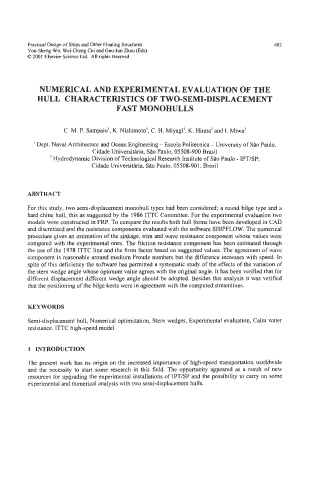Page 518 - Practical Design Ships and Floating Structures
P. 518
Practical Design of Ships and Other Floating Structures 493
You-Sheng Wu, Wei-Cheng Cui and Guo-Jun Zhou (Eds)
Q 2001 Elsevier Science Ltd. All rights reserved
NUMERICAL AND EXPERIMENTAL EVALUATION OF THE
HULL CHARACTERISTICS OF TWO-SEMI-DISPLACEMENT
FAST MONOHULLS
C. M. P. Sampaio', K. Nishimoto', C. H. Miyagi', K. Hirata' and I. Miwa'
' Dept. Naval Architecture and Ocean Engineering - Escola Politecnica - University of Ssio Paulo,
Cidade Universithia, SBo Paulo, 05508-900 Brad
' Hydrodynamic Division of Technological Research Institute of Ssio Paul0 - PT/SP;
Cidade UniversitSuia, Silo Paulo, 05508-901, Brazil
ABSTRACT
For this study, two semi-displacement monohull types had been considered; a round bilge type and a
hard chine hull, this as suggested by the 1986 ITTC Committee. For the experimental evaluation two
models were constructed in FRP. To compare the results both hull forms have been developed in CAD
and discretized and the resistance components evaluated with the sohare SHIPFLOW. The numerical
procedure gives an estimation of the sinkage, trim and wave resistance component whose values were
compared with the experimental ones. The friction resistance component has been estimated through
the use of the 1978 ITTC line and the form factor based on suggested values. The agreement of wave
component is reasonable around medium Froude numbers but the difference increases with speed. In
spite of this deficiency the software has permitted a systematic study of the effects of the variation of
the stem wedge angle whose optimum value agrees with the original angle. It has been verified that for
different displacement different wedge angle should be adopted. Besides this analysis it was verified
that the positioning of the bilge keels were in agreement with the computed streamlines.
KEYWORDS
Semi-displacement hull, Numerical optimization, Stem wedges, Experimental evaluation, Calm water
resistance. ITTC high-speed model
1 INTRODUCTION
The present work has its origin on the increased importance of high-speed transportation worldwide
and the necessity to start some research in this field. The opportunity appeared as a result of new
resources for upgrading the experimental installations of IPT/SP and the possibility to cany on some
experimental and numerical analysis with two semi-displacement hulls.

